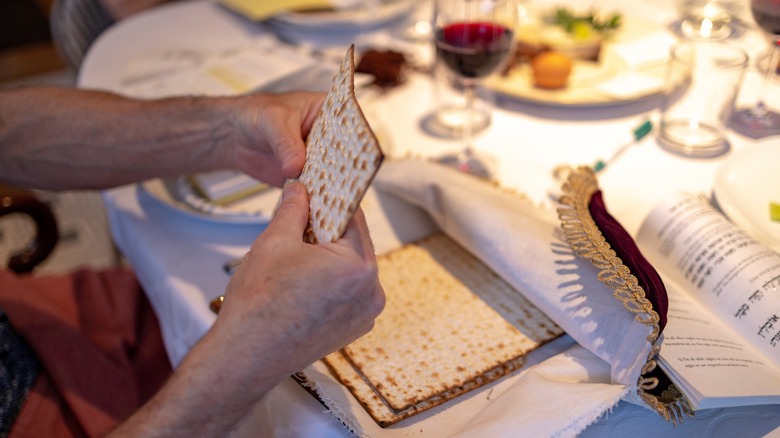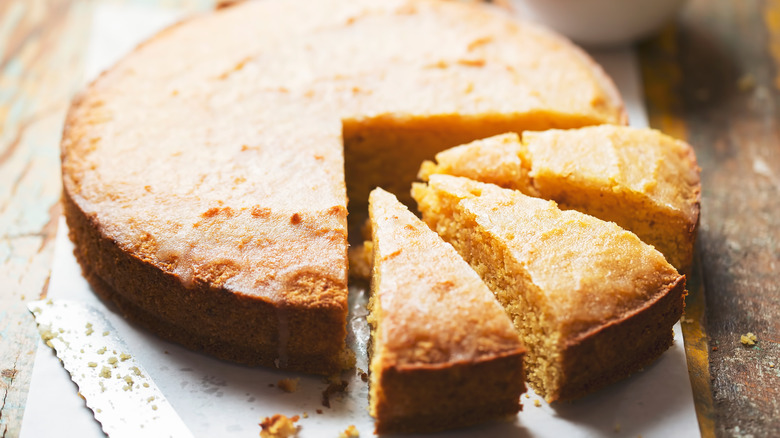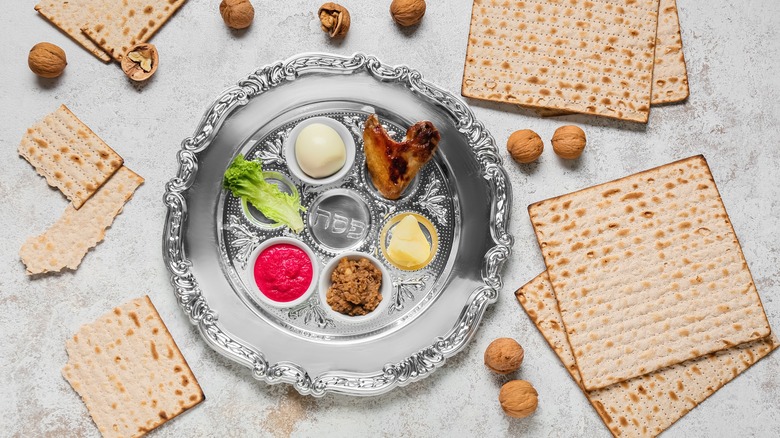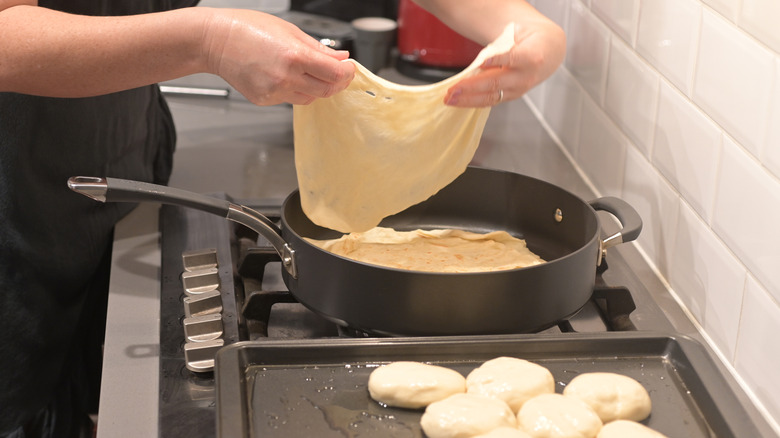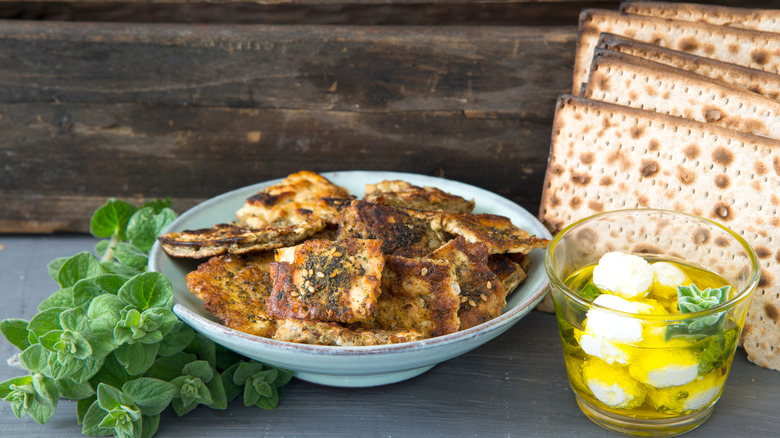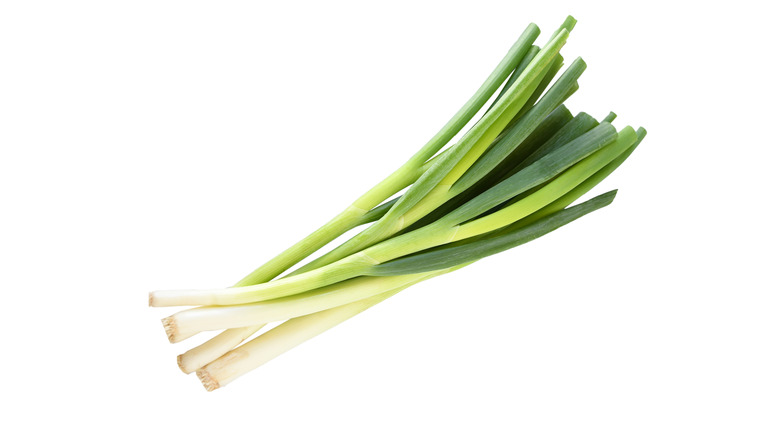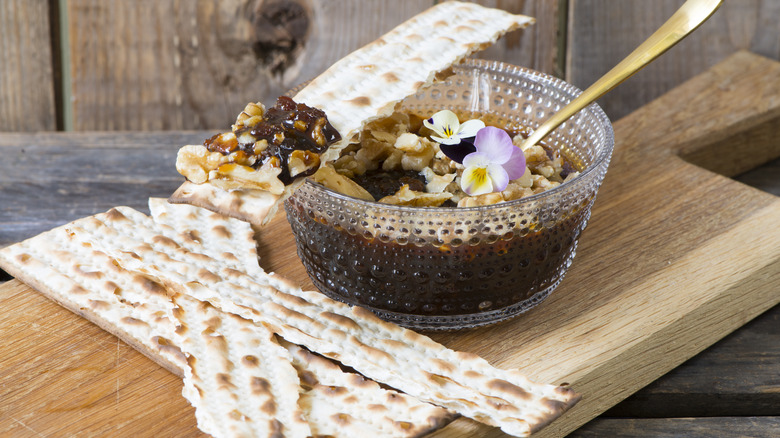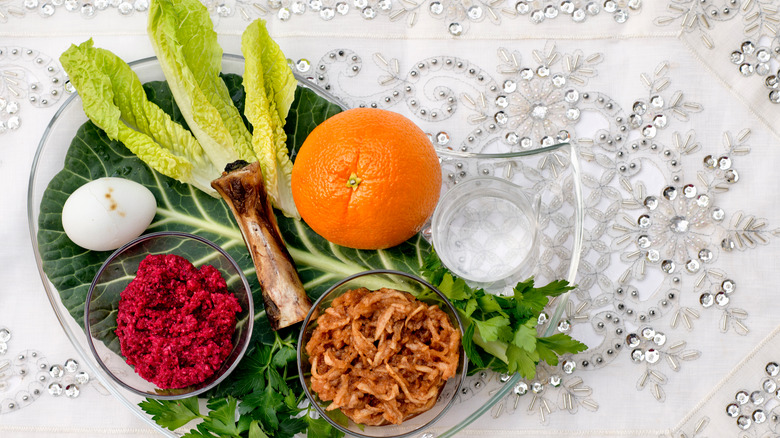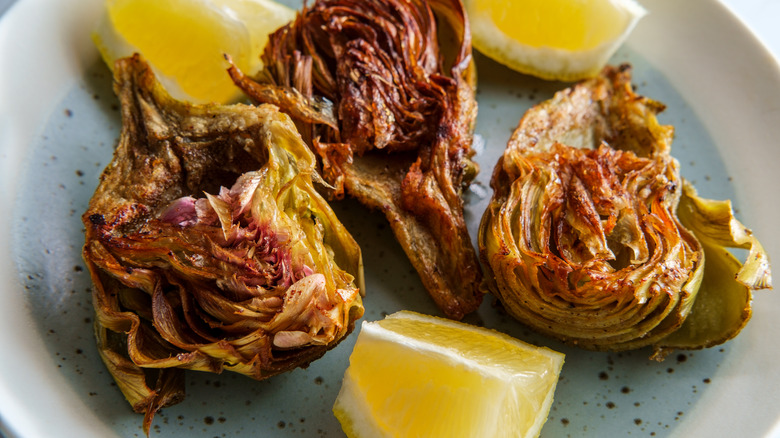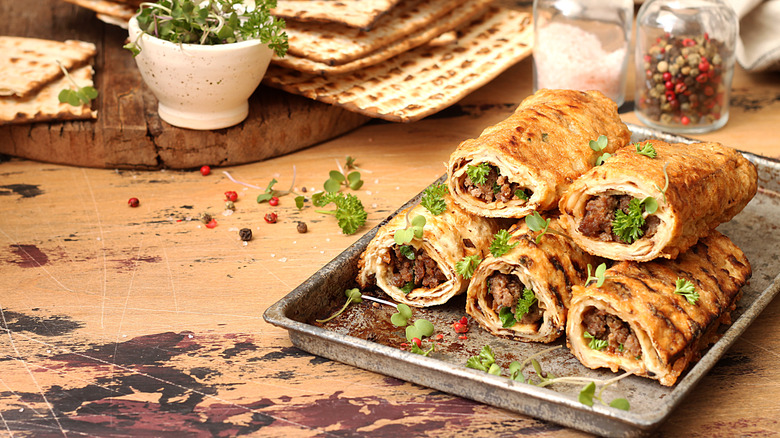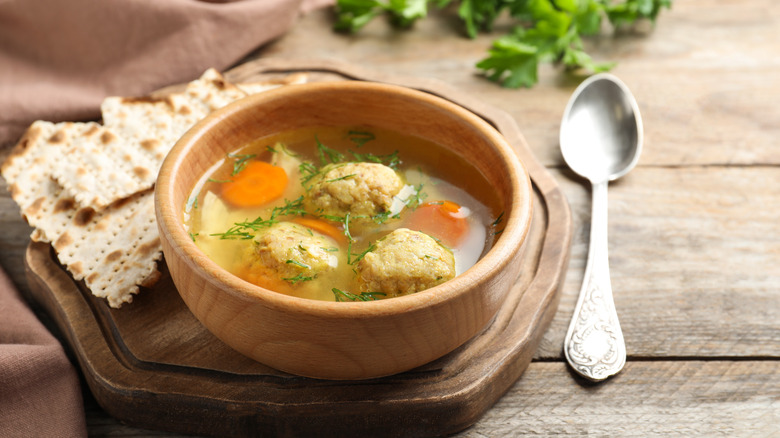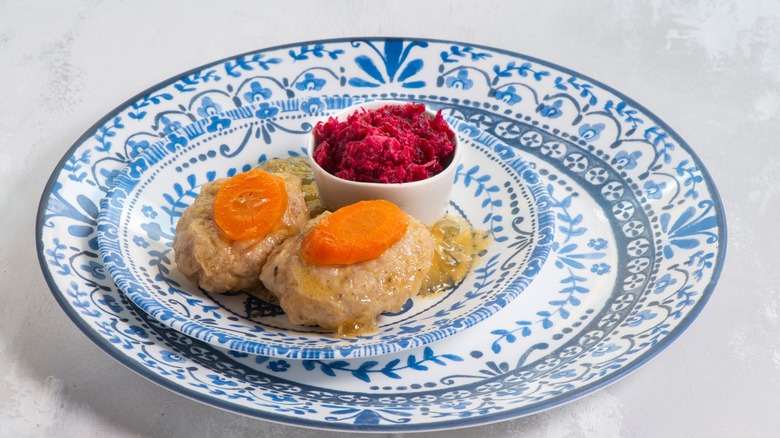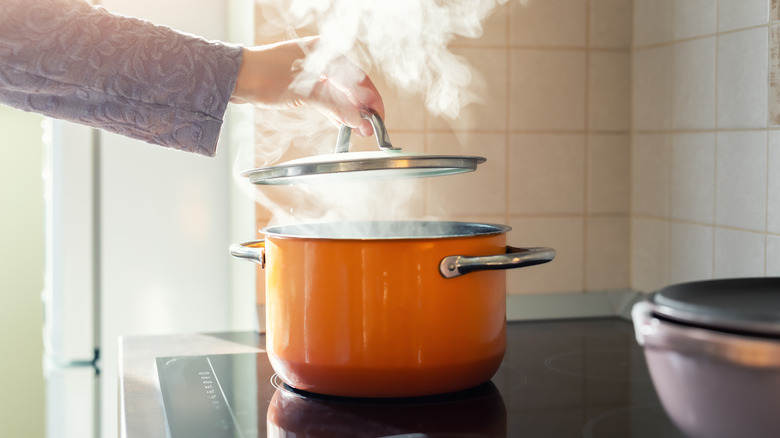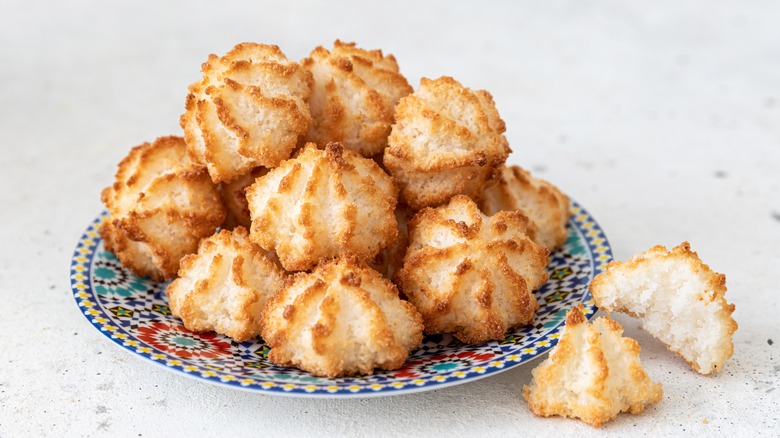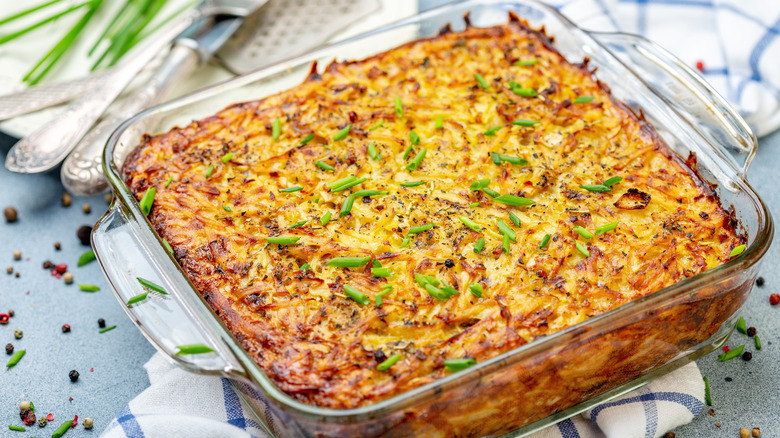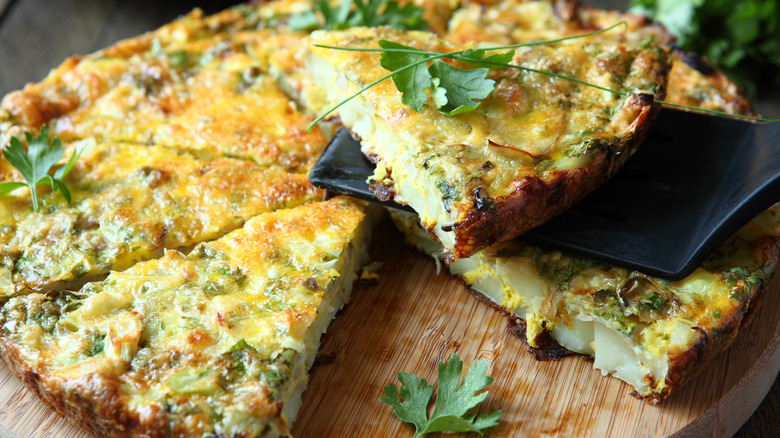15 Passover Dishes And Traditions From Around The Globe
Pesach, or Passover, is the eight-day Jewish holiday commemorating the Jewish people's exodus from ancient Egypt and its oppressive pharaoh. The celebration, which lasts for eight days, starts with a ritualized eating event known as a seder, during which the story of the Israelites' plight out of Egypt is told through song, symbolic foods, prayers, and rituals.
Depending on the diasporic community, many traditions, foods, songs, and eating restrictions are subject to change. However, despite their variations from region to region, the holiday revolves around several talking points, many of which are displayed as a seder plate or table dressing. Rituals also include the youngest at the table asking four specific questions, beginning with "Why is this night different from all other nights?" Attendees might recline on pillows, which are a symbol of freedom. There are other rituals, too, like the setting of an extra empty place at the table as a symbol of generosity to include the less fortunate, and the hunt for the afikomen, a special matzoh hidden for children to find.
Overall, Passover is a holiday celebrated at home with friends and family. During the remaining days following the seder (on the first or the first two nights), many will refrain from eating foods with leavening agents and flour to memorialize the efforts of Jewish people to emancipate themselves and their inability to wait for their bread to rise before leaving. Here are other traditions from around the world associated with the holiday.
Flourless desserts (everywhere)
Though the ritual before getting to the actual eating of the meal may seem to carry on forever (for some, seders can carry on for several hours before real eating starts), nothing is spared when it comes to the eating itself, with a seemingly endless stream of dished coming out from the kitchen. No matter how fussy an eater or large an appetite, it would be a great accomplishment to manage to leave the seder table hungry.
One of the main food features of Passover that extends beyond symbolism is the absence of flour. Though it may be seemingly difficult initially, this can extend to various desserts worldwide, including dishes created solely for the holiday, like matzo passover chocolate cake or meringues with a Manischewitz wine reduction. This flourless mandate also extends to other dishes existing within various cuisines, like the ground pistachio and orange blossom water macaroons, or cardamom-infused flourless cakes from communities of Syria and Iran.
Bitter herbs or maror (everywhere)
The eating of maror, Hebrew for bitter herb, occurs several times during the ritualized eating included in a Passover seder. According to the Haggadah, the book of stories, songs, and rituals performed during the meal, the bitter herb, often represented with horseradish on the seder plate, represents the harsh lives and suffering of the Jews who lived during that time. Not just ancient sorrow, there are also modern-day Haggadahs that help reframe the story to make it relevant for present-day life, citing the presents of modern-day oppressions alongside historical ones.
It's not just limited to horseradish alone (which, oddly enough, packs more heat than bitterness). Examples of this could also include bitter lettuces like romaine, dandelion greens, or chicory. When eating the bitter herbs, no matter the form, there are several ways to partake throughout the seder, including on its own, on a piece of matzoh, and alongside charoset. Each variation symbolizes something slightly different, included in the telling of the Passover story. Bitter herbs may also be included in the whole meal through a mixed leaf salad, horseradish, or chrain, a condiment in which horseradish is mixed with beetroot to accompany a piece of gefilte fish.
Mimouna (Morocco)
After eight days of rib-sticking, egg-heavy, flourless foods, the end of the holiday, a celebration known as mimouna in Morocco, is a joyous one. Though its exact origins are a bit murky, this post-Passover celebration, taking place in the evening and often extended into the following day after Passover, began within Sephardic communities in Morocco. Unsurprisingly, it has since spread to a wider community.
Foods eaten during this celebration can be rich in flour, like challah. In Libya, challahs made for Mimouna are often round, as are most challahs made for holidays, and also contain a whole hard-boiled egg in the very center. The holiday serves as an incentive to celebrate life and fertility, coinciding with the beginning of spring in the Northern Hemisphere. Rituals can include an abundance of rose petals and other flowers (and flours) alongside song, dance, and a dairy-rich meal made with copious amounts of buttermilk, and muflitas, a delicious, stretchy, and celebratory Moroccan pancake made with yeast and served with honey. Tables are often covered with a white tablecloth before being laid with symbols of fertility and abundance, including stalks of wheat, fruit, nuts, and even fish bowls, complete with live fish inside.
Matzoh Bimuelos (Spain & Turkey)
Bimuelos are a staple dish within many Sephardic communities, adapted to suit the season and celebration. They are fried fritters or pancakes and appear during holidays like Hanukkah, which celebrates everything fried.
Bimuelos, also known as binuelos, when made with matzoh, is a Sephardic dish that rivals that of matzoh brei — an Ashkenazic dish that includes sweet or savory fried egg-soaked pieces of matzoh. This simple dish yields an incredibly satisfying combination of soft and crunchy textures.
Matzoh bimuelos intensify these ideas with a deep-fried element that amplifies the satisfying crunchy texture achieved by frying egg-soaked-matzohs. Rather than done with individual pieces, bimuelos are fritters or pancakes, creating a crunchy outside and a soft, tender center. Using savory ingredients like Parmesan alongside a sweet syrup creates an irresistible combination perfect for any time of day. This item is especially popular in Spain and Turkey but is enjoyed in many parts of the world.
Scallion smacking (Iran & Afghanistan)
Many Jewish-identifying people who grew up going to reform or conservative synagogues in the U.S. will be familiar with the song "Dayenu" if for no other reason than its catchy, seemingly upbeat tune. The song itself is about oppression, originally written as a poem to God as a means of thanks for freedom and all of its joys, both big and small. Often, there will be clapping or banging on the table, becoming rowdier and more celebratory as the catchy refrain continues.
In Persian Passover traditions, this song often includes the presence of scallions, an oniony representation of the whips used during the oppressive era before the Israelite's emancipation and the exodus from Egypt. During the song, or in some cases just a reading of the poem, guests are welcome to grab a scallion and (gently) smack their neighbor in time with the tune or upon hearing of the word "dayenu." Dayenu takes the meaning of "it would have been enough" about God's many interventions in the story, as well as compelling listeners to acknowledge the many riches in their lives and their sufficiency without always needing more.
Charoset (Ashkenazic & Sephardic communities)
When it comes to symbolic foods eaten during Passover, charoset is number one on our list, with as many variations and versions as there were years spent wandering the desert. This sweet, nutty dish is made to symbolize the mortar used to build the pyramids.
A traditional Ashkenazic version of charoset is an apple-heavy affair, peppered with walnuts and raisins, then flavored with honey and wine. The finished texture is pleasingly chunky and versatile, making it easy to spread onto a matzoh cracker and eat on its own. Or, eat it with some horseradish or maror as a Hillel sandwich, an Ashkenazi custom that recognizes the feelings of sacrifice, sadness, and pain, symbolized by the bitter herbs can also contain feelings of hope and sweetness, represented here by the sweet charoset.
Sephardic charoset utilizes different ingredients to achieve the same sweet and tart flavors, using dates, dried apricots, and pomegranates with nuts like almonds and pistachios seasoned with warming spices like cardamom or cinnamon. Sephardic charoset tends to be blended to create more of a rich paste rather than left chunky. Equally delicious yet texturally different, we think there is a valid argument to include at least two charosets, one Ashkenazic and one Sephardic, at your next Passover seder.
Orange slice on the seder plate (LGBTQ+ communities)
This relatively new tradition is said to have first been done by Susannah Heschel, a professor of Jewish studies at Dartmouth College. In its original telling, Herschel demonstrated this ritual to her students, showcasing a segmented orange on the seder plate. Heschel suggested each person at the table enjoyed a slice, praying over it before eating to symbolize community support of the LGBTQ+ community, spitting out any seeds to symbolize the rejection of homophobia. Whether this was Heschel's personal ritual or one she learned is unclear.
The story has since been changed since its first telling. What many hear today is a story of Herschel being told that a woman belongs on the bimah of a synagogue, considered a sacred space due to its proximity to the Torah, as ridiculous as placing an orange onto a seder plate. Notably, though not all, many synagogues now welcome women into their clergy.
With the shifting of the story, so too did the focus of support, now centering the story on women in the face of sexism rather than community support for the marginalized LGBTQ+ community. Though there are many reasons to support both groups of historically marginalized people, we love how Heschel focused this tradition on the LGBTQ+ community and the greater community's role in providing support.
Roman fried artichokes (Italy)
Though the population is dwindling, there are still around 28,000 people who identify as Jewish living in Italy today, according to the U.S. Department of State. Italian, or more specifically, Roman Jewish food, is a cuisine of its own, drawing heavily on the array of delicious produce that thrives within the Mediterranean.
It's a cuisine heavy with ingredients of the region, like zucchini (and its delicate flowers), eggplant, olive oil, offal, artichokes, and pasta. One of the cuisine's most celebrated and iconic dishes is the Roman fried artichoke, known for its flavor and satisfying crunch. This is thanks to the expert knowledge of the Roman Jewish diaspora, who arrived in the city as far back as the second century. This group was joined by other, largely Sephardic Jewish diasporas, such as those escaping the Spanish Inquisition in the 1600s and a significant number of Libyan Jews in the 1960s, whose influence has also helped create the popular Jewish cuisines of the area today.
Roman fried artichokes show up on all occasions, big and small, from Hanukkah to Passover, or even just as a snack when feeding a group of friends or loved ones. Made from two of the region's most beloved ingredients, artichokes and olive oil, it's no surprise that this simple dish is a favorite of many, Jewish or otherwise.
Minas (Turkey, Greece, Spain, Egypt)
Minas, mayeena or maiena, as they are often called in Egypt, is a matzoh-based stuffed pie filled with meat or vegetarian options like leeks or spinach. These green, bright vegetables also have a symbolic purpose, meant to signify the coming of spring and new life, alongside other foods on the seder table. Minas are traditional Sephardic dishes made around Passover, eaten throughout the week, and on the seder table.
Their fillings also incorporate Sephardic staples, including warming spices like nutmeg, cinnamon and allspice, feta, pine nuts, lamb, and more. The crust is made by soaking matzoh crackers in stock, often chicken is chosen, until soft and pliable.
Pies such as minas show up a wide variety of Sephardic cuisines, showcasing Jewish communities' ability to mix, adapt, and contribute to numerous countries worldwide, with dishes often eventually being absorbed into the popular culture of the area.
Matzo ball soup (Ashkenazic communities)
Matzo ball soup is a classic Ashkenazi food tradition, a cure-all anytime dish that has made its way from the hands of bubbies everywhere (the Yiddish word for grandmother) into the ubiquitous kosher-style delis across the U.S. and the general lexicon of the American public. Given its popularity and ingredients, it often finds its way onto the Passover table, often just before or after the gefilte fish in an Ashkenazic home.
Matzo ball soup makes for the perfect vehicle for gently transitioning between the ritualized eating that takes place during the telling of the readings from the Haggadah, the book containing the Passover stories, songs, and prayers, and the full-on feast about to come streaming out of the kitchen.
Traditionally, like many other Ashkenazic dishes, matzo ball soup relies on schmaltz or chicken fat to achieve its rich, comforting flavors. The dish is simple to make, relying on only three base ingredients: matzo, fat, and eggs. We think that simplicity is all the more reason to make it regularly, both for Passover and long after the holiday finishes.
Gefilte fish (Ashkenazic communities)
Though many will recognize gefilte fish as the grey balls suspended in a clear jelly-like substance in the "Jewish foods" section of the grocery store, there is so much more to this fish-based product than meets the eye (thank goodness for that).
The name means "stuffed" in Hebrew, indicating its original form, referencing a stuffed pike fish. The recipe first appeared in a German cookbook around the 14th century. As it was originally made, the dish was a popular item within Catholic communities during the celebration of Lent, during which many will refrain from eating meat in observation. Eventually, the dish evolved, changing from its original form and the community of people who ate it, to what it now looks like today, essentially a boiled fish meatball made from a mixture of white fish, eggs, and matzoh meal, having been adopted by Eastern European Jews.
Interestingly, in England, rather than boiling and serving cold, as is popular in the U.S., British Jews most commonly deep fry the fish balls, served hot or at room temperature, alongside a dollop of chrain.
Minestra Dayenu (Italy)
Many will be familiar with the first part of this dish. The name minestra is a general term but a foundational one, the basis by which the one-pot-wonder of a soup made with beans, vegetables, potatoes, and pasta and a tomato-based broth was created. Like many others, Italians created the soup to use up any leftovers, stretching every edible item in the house to feed as many mouths as possible.
The word dayenu translates to "enough," "it would have been enough," or "enough for us." It appears in a popular Jewish song/poem sung or read during the Passover seder. It acknowledges both the hardships and blessings in the story of the Jewish people's exodus from Egypt and the oppressive rule of the then-pharaoh.
A particular version of this soup appears in Claudia Roden's "The Book of Jewish Food," sent to her by a cook in Turin, Italy. It has but four ingredients: seasoned chicken stock, matzoh, egg yolks, and cinnamon. There are many other versions of the soup, including one containing chicken meatballs, inspired by another Italian Passover soup, Minestra di Rico. However, as the song's catchy refrain emphasizes, should you wish to use the paired back version, a characteristic often present in Italian cuisine, it will be enough.
Macaroons (North America)
In North America, coconut-based macaroons, not to be confused with the almond flour-based French version, are often present on the Ashkenazic Passover seder table, alongside or following other flourless desserts. Whether you make them yourself or pick up a canister of pre-made, this sweet, chewy cookie makes for an incredibly satisfying bite or two; the perfect ending to a night of songs, stories, and copious amounts of food.
Macaroons are made without dairy, leavening agents, or flour, so macaroons meet both kosher and Passover requirements, making them an easy addition to a kosher or kosher for Passover meal.
Despite its popularity within Ashkenazic Jewish American culture, the sweet treat originates in medieval times, a combination of both Arabic and Italian cuisine, making its debut North American appearance in Esther Levy's "Jewish Cookery Book" in 1871. At the time of publishing, and for quite some time afterward, shredded coconut, the basis of the cookie, would have been prohibitively expensive, making them a cookie only for the upper crest, much like the subject matters within the said cookbook.
Thanks to the invention of machinery that could shred and dry the coconut, this price point eventually lowered, helping to put the product into popular Jewish-owned department stores, making it affordable and increasingly popular for many middle-class Jewish communities. After WWII, when convenience foods began to soar, pre-made macaroons came into an even more widespread culture, helping to achieve the coconut macaroon's current popularity and commonplace status.
Kugel (Ashkenazic communities)
Kugels have a long history within German culture and the Ashkenazic Jewish community. Originally the dish was served in and around the 12th century as a dumpling, made from bread and a bit of egg, cooked in a traditional cholent, a slow-cooked stew cooked overnight and served on Shabbat, when work, such as cooking, was not to be done. Eventually, the dish was cooked separately in its own pot, then placed on top of the cholent; the steam from the stew worked to keep the kugel moist and tender.
As time passed, additional ingredients such as sautéed onions and schmaltz staples in Ashkenazic cuisine were added. Rice kugels became popular around the 16th century, thanks to the influence of the Ottoman Empire within Europe. Eventually, sugar was added once it became more affordable and popular in European cuisines around the 17th century. Noodles emerged in the 18th century from a Jewish diaspora in Jerusalem. Potatoes appeared as late as the 19th century during their reign of popularity in Europe. As time and culinary trends affected the dish, we can see hints of the modern-day interpretation of this centuries-old dish.
Today, kugel comes in various forms; as history dictates, all are equally valid. The kugels that make their way to the Passover table, however, will forgo the noodles and rice (if Ashkenazi) and instead be potato or root vegetable-based, using a matzoh meal and egg binding rather than flour.
Quajado or Cuajado (Sephardic communities)
Quajados are a Sephardic Passover staple made from various ingredients, often including leeks, potato (once in fashion in the 19th century), tomato, or spinach. The vegetables are then bound together by eggs and an optional salty, strongly flavored cheese like feta or Parmesan. Its name stems from the Spanish word asquajado, which means 'coagulated' or 'having curds,' and perfectly describes this soft-yet-sturdy casserole or kugel-type dish. Many compare the final texture of a quajado to a frittata, as it's cooked in much the same way.
The dish dates back to pre-inquisition Sephardic communities in and around Spain and parts of Portugal. According to some, cooking a quajado became a highly suspicious activity and one that might out a family for celebrating their at-the-time-illegal Jewish heritage, especially if made on Shabbat. This dish is typical within Sephardic cuisine, often on any celebratory table from Shabbat to Passover, served either warm or at room temperature.
